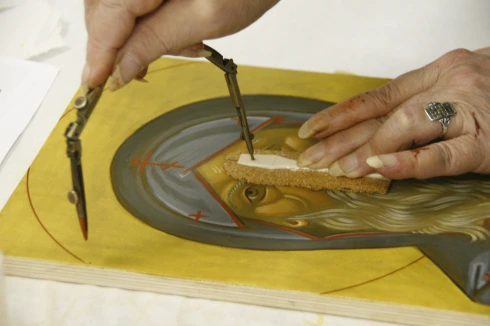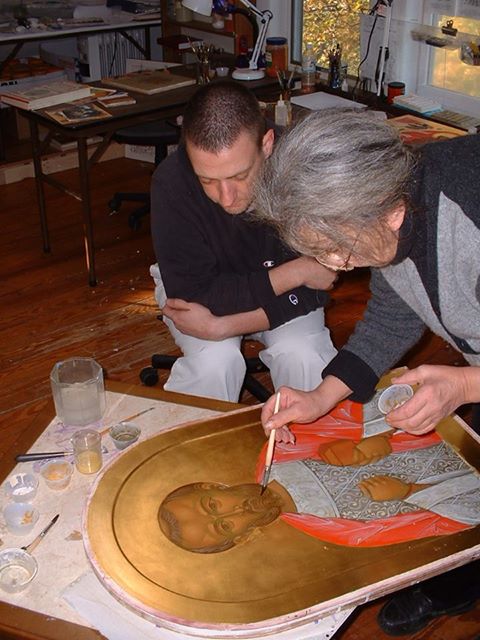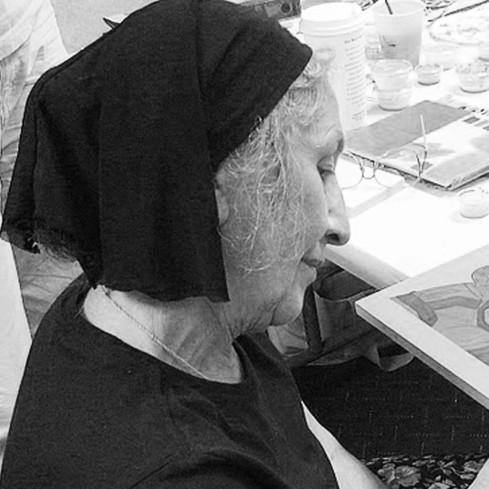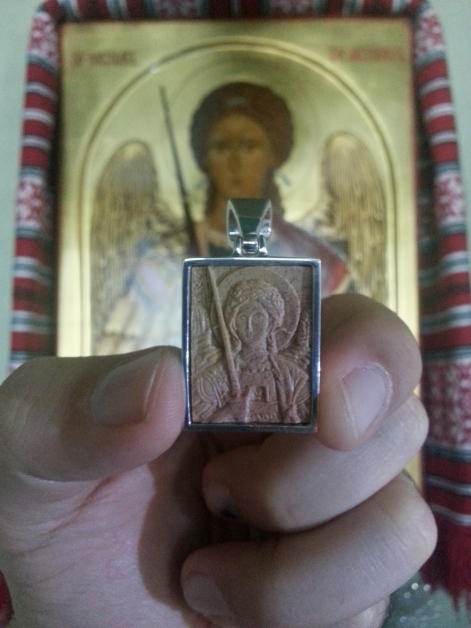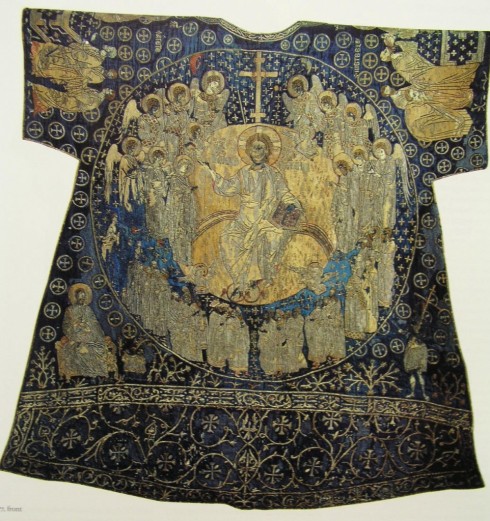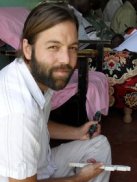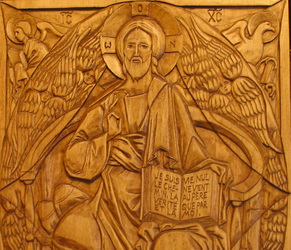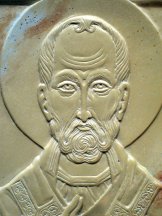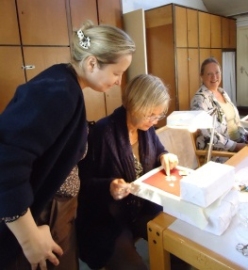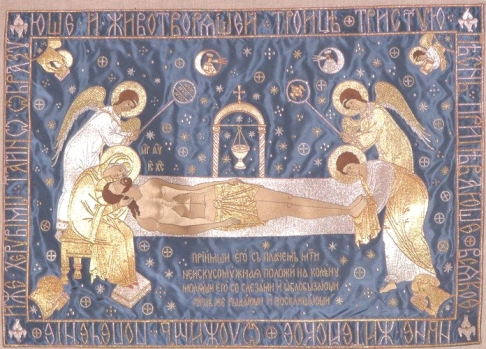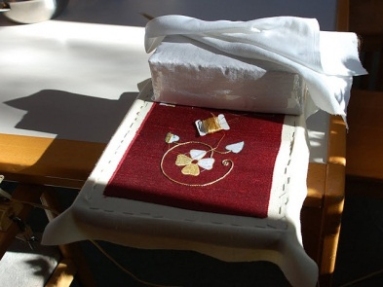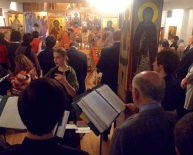Perhaps it was inevitable. The technology has been in place for decades. It was only a matter of time before the sacred art of the icon became an inexpensive do-it-yourself room makeover. For those of us who support sacred arts through training iconographers and encouraging high quality work crafted from noble materials for our churches and homes, the creation and dissemination of icon wallpaper is a cause for mourning.

Fresco of angel in St. Sophia Cathedral, Vologda
We recently received an advert email for “Priests and Wardens” that touted the benefits of a process for manufacturing “images that go on your church walls like wallpaper. MUCH cheaper than real frescoes!”
We were even warned “there is an ‘imposter’ out there using cheaper materials, so be careful!”
Imagine, an “imposter” of the “MUCH cheaper than real.” Really?
There is a story told about Henry Ford that comes to mind. You remember the businessman from Detroit who made it affordable for just about everyone to own an automobile. After the inventor of assembly-line production amassed so much wealth he didn’t know what to do with it, his financial advisors suggested he invest in fine art. But the acquisitive Ford was taken aback by the sticker price on the art pieces brought before him. So, he ordered photographs to be taken of the art and the paper copies placed in fancy frames to hang throughout his mansion[s]. The idea caught on and the art reproduction business was launched. Once again Ford had succeeded in finding a way to make something of value accessible to the masses. Now, everyone can own a Rembrandt that is “MUCH cheaper than real” because it isn’t.
Ford’s ingenuity worked well for auto assembly and we are thankful for it, but aping his thrift in artificial art production (whether high-end imposter or low) is a tragedy for iconography. Ironically, no one has ever argued that the artificial imitation of fine art works is real. That argument seems to be reserved for the sacred rather than the secular.
We were further told, “This method of displaying beautiful iconography has been blessed by Bishops and supported by priests all over the world.” Of this there is no doubt. But let us consider the inspiration for and the consequences of such blessings.
The argument for the artificial, with only a few laymen to oppose it, rests upon defunding the artist and capitalizing on his or her work, made easy because icons are rarely copyrighted. This was Ford’s inspiration. Although he could easily afford a Cézanne, Ford placed a higher value on a paltry imitation because it served the purpose of providing decorations without paying big bucks for the real thing. While this is hardly the reasoning of bishops, priests and parish councils trying to adorn temples out of their penury, the effect is the same.
Since costly items of infrastructure cannot be substituted with photographs of furnaces, plumbing and electrical systems just because the parish can’t afford them, the “blessing” seems to indicate that the more essential elements of Orthodox worship can be illusory. The implication is that icons are merely decorative accessories like, well – wallpaper. A similar mentality reigns for individuals who shell out $1500 to $3000 on a widescreen plasma TV without batting an eye, but are only willing to spend twenty bucks on a photograph of the Sinai Christ glued to a piece of particleboard.
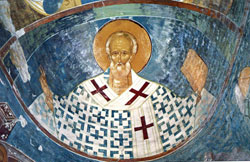
Fresco by Dionisy in Ferpontov Monastery
As our email advertiser educates us: “Images are representations. The medium used does not play a role in the validity of the object/person being represented.”
Thanks, Henry!
Of course Orthodoxy does not [officially] consider icons as decoration. But this does not mean that Orthodoxy, which takes its very appellation from the victory over iconoclasm, is immune to iconoclasm manifest in new forms.
Consider the words of renowned Russian iconographer Archimandrite Zinon:
“In speaking about the icon, one could say that today it does not occupy its rightful place in the divine service, nor is there a proper attitude towards iconography. It has long ceased to be regarded as “theology in color”; people don’t even suspect that it is capable of conveying the teaching of the Church just like the word, and that it can likewise give false witness instead of witnessing to the Truth. The icon has become a mere illustration of the celebrated event, and for this reason it doesn’t matter what form it takes, because nowadays even photographs are venerated as icons.”
“A mere illustration of the celebrated event” sounds a lot like our email advertiser of wallpaper bargains.
And then there are the “weeping paper icons“ so invincibly offered as proof that “themedium used does not play a role.“ We can talk all day long about the meaning of dripping photographic paper, and bishops, priests and monks do, regardless of what is at stake. In this strange twist of anti-materialistic logic the lesson gleaned seems not to be miraculous intervention but that we can replace the holy icons with a soulless materialism that merely illustrates what an icon is.
In photographic illustrations of icons, real gold becomes an RGB algorithm as do the other noble metals and semi-precious stones of the iconographer’s palette. The image is pixilated but the icon is absent. The prayerful dialogue between God and the human hand, between the bounty of the created world and its divine source are annihilated in the toxic vapors of print production.
Romantic, are we? Or are we simply defending the integrity of the icon against its falsification? Mounted photographs of icons may have a place in Orthodoxy, something akin to sturdy teaching tools for Church School children or illustrations for events, but in no way should they be permanently incorporated into our worship services.
As a succinct articulation of a profound objection to the faux-fresco industry and its like, we re-post here excerpts from an interview presented in a 2010 Hexaemeron Newsletter. The full article on Liturgical Renewal printed in Orthodox America explains among other things why “colored photograph is unacceptable for use in church” as are other forms of imitation such as artificial flowers. It is regrettable that the remarks below may be treated as obsolete fetishes of fanatics rather than guiding principles. This is obviously because our priorities have become more aligned with Henry Ford’s than we could ever have imagined. Under communism the icon was threatened with violence; under capitalism with banality. God help us!
This discussion occurred in 1990 between Archimandrite Victor, rector of St. Euphrosyne of Polotsk Church in Karsava, Latvia and Archimandrite Zinon, who was then serving as an iconographer of the Pskov-Caves Monastery. It speaks directly to the misleading mixing of terms in the statement “the medium used does not play a role in the validity of the object/person being represented.” The self-deception imbedded in this bold claim is that it confuses the “validity“ of the immutable and transcendent prototype (person) with how the prototype is “represented.” Attend closely to why the materials used to represent divine presence DO play a role in every image that serves as an encounter between God and man, be it the vestments of the clergy or the flowers we bring to express our love for our Savior’s accomplishments upon the Cross.
Fr. Zinon: In the Moscow Patriarchate Journal, 1989, No. 10, there is an article by L. A. Ouspensky about colors in icons. It explains very simply and convincingly why a colored photograph is unacceptable for use in church: it only imitates color; it has no color of its own. For this reason it cannot serve as a substitute for a painted icon. An icon must witness to the Truth, and here we introduce something false, artificial; this cannot be.
Fr. Victor: This is the same as having artificial flowers in church. Patriarch Alexis I asked that they not be brought into church, because there is no truth in them.
Fr. Zinon: Even earlier, Metropolitan Philaret (Drozdov) of Moscow said that imitation gems and imitation metals should not be used in church not because they are not costly but because they contain falsehood. Gold was always costly; where it was unattainable, ordinary but natural materials were used. For example, the traditional background for icons has always been gold leaf (or silver). In poor churches, especially in northern Russia, all backgrounds were painted with light colors. To be more precise, “background” is not a Russian word; iconographers call it “light”.
Fr. Victor: Because God is light.
Fr. Zinon: And lives in unapproachable light.
Fr. Victor: One can say that nowadays we see a decline in religious understanding; the dogma of icon veneration has been forgotten, supplanted with the veneration of artificiality. And this is not simply forgetfulness, but rather a rupture with the living Tradition of the Church, a scornful attitude towards the Holy Fathers and to the decrees of the Ecumenical and Local Councils. One must restore the veneration of icons in its genuine significance.
Fr. Zinon: This problem must be resolved at the Synod level; it should be a matter for the whole Church. Today churches are being returned to us, monasteries. They all require iconographers, but so far there isn’t a proper school for iconographers. I know many young people, talented and eager to study, but the means for this are lacking. Some are tied to families and can’t travel far, others are free but have nowhere to study. Our hierarchs have made efforts to increase the number of clergy: diocesan schools are opening, there are courses for readers, seminaries. But I have yet to hear of any school, even a small one, for iconographers. And this despite the fact that almost every week someone comes to me with a request to paint an iconostasis or fresco a church. Here is further evidence that the icon has been eliminated from the divine services; it is no longer given due attention. What is sold in church kiosks, the mass reproductions produced in the shops of the Moscow Patriarchate, do not comply with the requirements applied to church art.
In the Synodal period there appeared many depictions, which can plainly be called mockeries, parodies of icons. Last time I gave you to read some letters by Bishop Ignaty Brianchaninov. In one of them he writes that he saw not icons, but caricatures of icons. At best these could be called well-executed paintings, but by no means icons. This was written in the last century, when churches were filled with this sort of art and the Orthodox icon was branded as “Old-Believer” or barbaric art. (The well-known historian, Karamzin, seeing the ancient frescoes in Novgorod’s St. Sophia Cathedral, called them “barbarian”.)
Fr. Victor: L. A. Ouspensky, in his book, The Theology of the Orthodox Icon, accurately observes that in the iconoclast period the Church fought on behalf of the icon, while in our time of troubles the icon is battling for the Church.
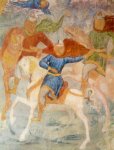
Magi fresco, St. Sophia Cathedral -Vologda
As a non-profit organization dedicated to the sacred art of the icon, we see the other side with a clarity that transcends competition for market share among wallpaper imposters. Our students sacrifice not only thousands of dollars in pocket layout to study the theological and aesthetic goals of the ancient tradition that have been organically transmitted from the first icons painted on the walls of martyrs tombs, but they also offer up hundreds of hours of time away from their families and their employment to prepare themselves to serve God’s Holy Church with hard acquired skills and knowledge of temple adornment.
The reality from the other side is that even the best-trained iconographers are often passed over for “MUCH cheaper” amateurs, or they are asked by priests and bishops to donate their work. Many, many gladly do so out of willingness to serve, but at the expense of the tradition that should support them. All this haggling over not wanting to remunerate real iconographers at the rate of legal minimum wage is destroying the future of iconography everywhere. If, as our e-mailer suggests, priests and wardens turn to the “cheaper than real” catalog for adorning their temples, there will no longer be a need for icon painters. And just as every office and hospital wall is mounted with an artificial Degas or Cassatt, so will every temple have a cheap photograph of the Rublev Trinity smoothed large on drywall surfaces “like wallpaper.”
This glimpse into the realities of practicing iconographers is portrayed here in mere economic terms as a flip side of the Ford mentality troubling our parishes, but the greater issue of artificiality is as Fr. Zinon says, “a matter for the whole Church” to resolve.
Mary Lowell

